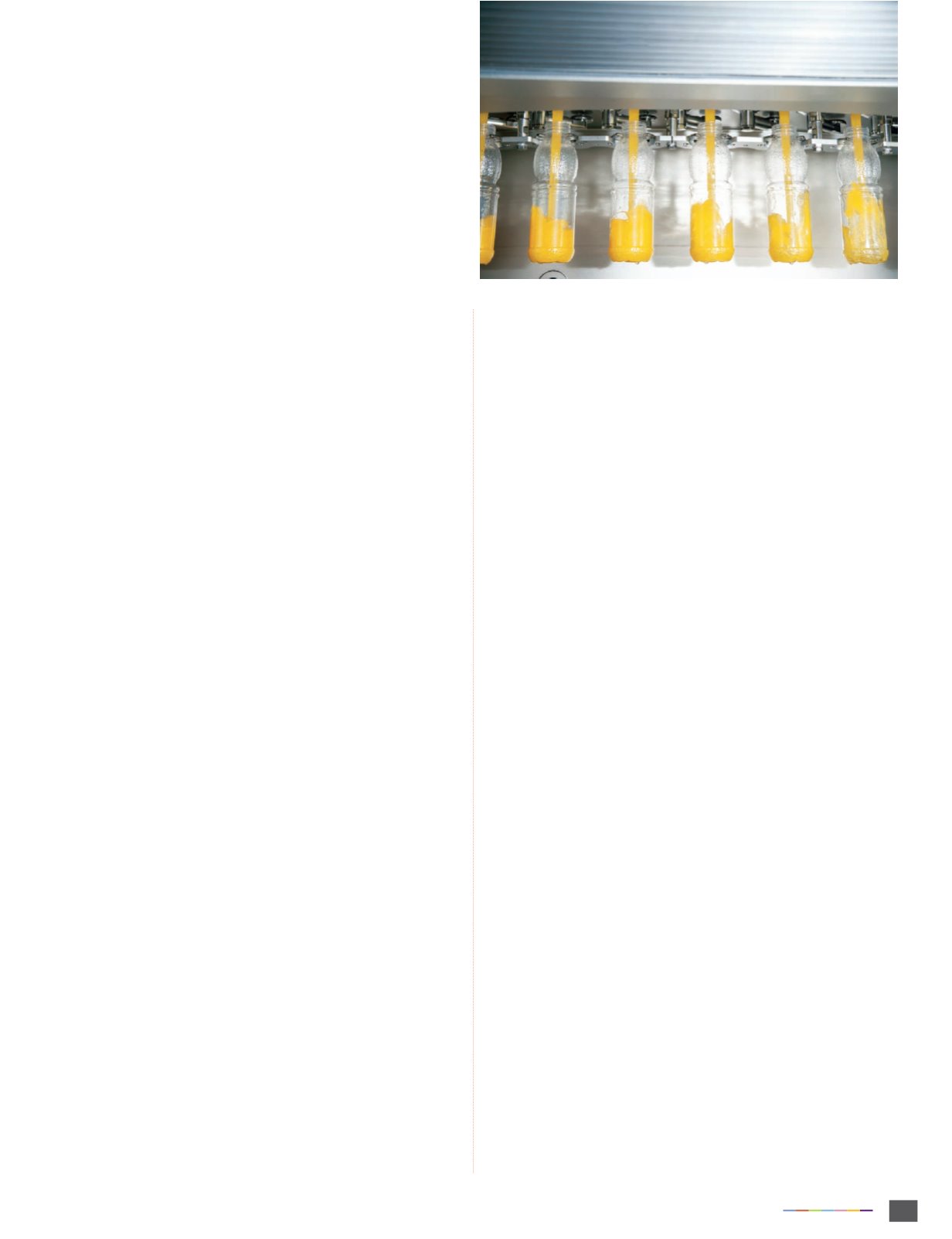
Food Focus Thailand
JUNE 2013
51
Opted for Inline Blending
การรั
กษาชิ้
นเนื้
อผลไม
ในกระบวนการผลิ
ตน้
ำผลไม
ที่
มี
ชิ้
นเนื้
อผลไม
ให
ยั
งคงรู
ปอยู
ได
ตั้
งแต
ขั้
นตอนแรกจนถึ
งขั้
นสุ
ดท
ายถื
อเป
นป
จจั
ยที่
สำคั
ญมาก
รวมถึ
งการบู
รณาการระบบที่
จะดำเนิ
นการควบคุ
มองค
ประกอบ
ของผลิ
ตภั
ณฑ
ก็
มี
ความจำเป
นเช
นกั
น และจากประสบการณ
ของ Coca-
Cola HBC Eurasia ที่
ได
รั
บในประเทศอื่
นๆ บริ
ษั
ทมี
ทางเลื
อกต
อไปนี้
เพื่
อเลื
อกดำเนิ
นการ:
• การบรรจุ
ร
อน ในสายการผลิ
ตแบบทางเดี่
ยว
• กระบวนการผลิ
ตแบบปลอดเชื้
อในสายการผลิ
ตแบบทางเดี่
ยว
• การผสมสำเร็
จแบบต
อเนื่
องและปลอดเชื้
อในสายการผลิ
ต
แบบคู
ขนานและแบบเดี่
ยว
• สายการผลิ
ตแบบคู
ขนานและสายการบรรจุ
แบบหั
วคู
ทั้
งแบบร
อนและแบบเย็
น
ผลตอบรั
บที่
ได
จากการใช
ไลน
การผลิ
ตเป
นการยื
นยั
นว
าไลน
การผสมสำเร็
จแบบต
อเนื่
องและการบรรจุ
แบบปลอดเชื้
อ
4
สามารถรั
กษา
คุ
ณภาพของชิ้
นเนื้
อผลไม
ระหว
างการผลิ
ตได
อย
างดี
อี
กทั้
งยั
งสามารถ
เติ
มชิ้
นเนื้
อผลไม
ผสมได
อย
างแม
นยำ และให
ผลผลิ
ตที่
สู
งอี
กด
วย การผสม
สำเร็
จแบบต
อเนื่
อง คื
อ การเตรี
ยมชิ้
นเนื้
อผลไม
และน้
ำผลไม
แบบ
ปลอดเชื้
อแยกกั
นแล
วนำมาบรรจุ
ขวดเข
าด
วยกั
น Natalia Polozova
ผู
จั
ดการฝ
ายวิ
ศวกรรม Coca-Cola HBC Eurasia กล
าวว
า “เป
าหมายของเรา
คื
อ การที่
จะทำให
การดำเนิ
นงานเป
นไปอย
างนุ
มนวลที่
สุ
ดเท
าที่
จะ
เป
นไปได
เพื่
อลดความเสี
ยหายของชิ้
นเนื้
อผลไม
”
How the Pulpy Products are Made
ชิ้
นเนื้
อผลไม
ถู
กส
งมายั
งโรงงานแบบแช
แข็
งในถั
ง 180 กิ
โลกรั
ม
หลั
งจากนั้
นจะถู
กนำไปละลายใช
เวลาประมาณ 24 ชั่
วโมง เพื่
อให
สามารถ
นำเข
าสู
กระบวนการได
ซึ่
งลั
กษณะที่
เป
นที่
ต
องการหลั
งการละลายก็
คื
อ
การไม
มี
เศษน้
ำแข็
งหลงเหลื
อในผลิ
ตภั
ณฑ
อุ
ณหภู
มิ
ไม
ต่
ำเกิ
นไป และ
ผลิ
ตภั
ณฑ
ผสมเป
นเนื้
อเดี
ยวกั
น ผลิ
ตภั
ณฑ
เมื่
อถู
กละลายจนได
คุ
ณสมบั
ติ
ดั
งกล
าวก็
จะเข
าสู
ขั้
นตอนการพาสเจอร
ไรส
และทำให
เย็
นลงอย
างรวดเร็
ว
ที่
อั
ตราประมาณ 2 ลู
กบาศก
เมตรต
อชั่
วโมง ทั้
งนี้
ขึ้
นอยู
กั
บสู
ตรน้
ำผลไม
แต
ละชนิ
ด ในขั้
นต
อไปผลิ
ตภั
ณฑ
จะถู
กลำเลี
ยงและให
ความร
อน
ผ
านเครื่
องพาสเจอร
ไรส
แบบท
อ อาศั
ยป
มแบบ Screw-spindle เป
น
ระยะทางสั้
นๆ ไม
คดเคี้
ยวนั
ก และไม
มี
วาล
วควบคุ
มระหว
างทางเดิ
น
ของผลิ
ตภั
ณฑ
จึ
งทำให
ผลิ
ตภั
ณฑ
ได
รั
บการกระทบกระเทื
อนน
อยที่
สุ
ด
หลั
งจากที่
ผลิ
ตภั
ณฑ
ชิ
้
นเนื้
อผลไม
ผ
านการให
ความร
อนและทำให
เย็
นลง
อี
กครั้
งก็
จะถู
กส
งไปยั
งถั
งฆ
าเชื้
อที่
มี
ความจุ
10 ลู
กบาศก
เมตร ติ
ดตั้
ง
อยู
ใกล
กั
บเครื่
องบรรจุ
หลั
งจากการแปรรู
ปชิ้
นเนื้
อผลไม
แช
แข็
งแล
ว ชิ้
นเนื้
อผลไม
พร
อมใช
จากเครื่
องผสมแบบปลอดเชื้
อจะถู
กส
งไปยั
งเครื่
องบรรจุ
ณ จุ
ดนี้
การลด
ระยะทางและการดู
แลลดความเสี
ยหายของชิ้
นเนื้
อผลไม
ไม
ให
เสี
ยลั
กษณะ
เป
นป
จจั
ยที่
ต
องให
ความสำคั
ญมาก ซึ่
งพบว
าผลิ
ตภั
ณฑ
สุ
ดท
ายที่
ได
ออกมา
มี
ความสมบู
รณ
ตามที่
Coca-Cola HBC Eurasia ได
วางไว
ทุ
กประการ
gained in other countries, Coca-Cola HBC Eurasia had the following
alternatives to choose from:
• hot-filling in a single-flow process
• an aseptic process in single-flow mode
• aseptic inline blending with a twin-flow process and
single-flow filling
• a hot or cold twin-flow process both for product processing
and for bottling on a dual filler
Empirical feedback from actual operations had confirmed that aseptic
inline blending
4
offered very good preservation of the pulp, excellent
dosing accuracy, and a high line output. Inline blending means that pulp
and juice are aseptically prepared separately and then bottled together.
“The paramount goal was to make the operation as gentle on the product
as possible and to minimise damage to the fruit cells”, emphasises Coca-
Cola HBC Eurasia’s Country Engineering Manager.
How the Pulpy Products are Made
The pulp is delivered frozen in 180 kilogram drums. To enable it to be
processed, it first has to be thawed for around 24 hours. This is done
inside the hall at ambient temperature. The slurry is required to exhibit
defined proportions of pulp and juice, there must be no more ice in the
mixture, the temperature should not be too low, and the mixture has to
be homogeneous. When the slurry meets these criteria, the product is
released by the laboratory, heated up in the pasteuriser, and cooled down
again. The pasteuriser’s output is approximately two cubic metres an hour,
which can be individually set in each recipe. Through cross-corrugated
tubes, the slurry is then gently and dependably heated up in the shell-and-
tube heat exchanger, and delivered by screw-spindle pumps. Minimised
distances, few changes of direction in the system, and elimination of
control valves in the product path ensure that the product is handled
with maximised gentleness. After the slurry has been heated up in the
system, and then cooled down again, it is passed to the sterile tank, with
a usable capacity of 10 cubic metres, installed near the filler.
The finished beverage from the aseptic blender is supplied to the filler.
And here, too, particular attention has been paid to minimised distances
and maximally gentle handling. The finished beverage in the bottles meets
all of Coca-Cola HBC Eurasia’s quality stipulations to perfection. To quote
Natalia Polozova: “Pulpy is something rather special. The fruit chunks
create freshness on the tongue as if you’re drinking freshly squeezed
juice.” At the moment, Coca-Cola HBC Eurasia is using Line 1 solely for
bottling Pulpy Orange in the 0.45 litre container at a speed of 42,000
bph. Two more Pulpy products are set to follow in 2013.
Fourth Line with Preform Decontamination
3
In 2011, Coca-Cola HBC Eurasia had for the first time embarked on a
paradigm shift. After three Aseptic lines
4
with separate blow-moulders


